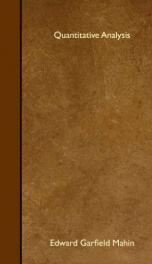quantitative analysis

This book cannot be classed as a complete reference work on quantitative analysis, neither is it a bare outline of laboratory exercises. The author has felt a desire that has probably been felt by every teacher of quantitative analysis, to produce a book that would cover the ground that he wishes to cover in the college courses, providing a reasonable degree of latitude in the selection of exercises for other possible users of the book, and at the same time to present a theoretical and practical discussion of the subject, sufficiently simple to be comprehended by the average stu-. dent but not so elementary as to destroy his self-respkct. One of the most difficult tasks connected with the teaching of quantitative analysis is to produce in the mind of the student a clear comprehension of the scientific development of quantitative methods. There seems to be a more or less unconscious tendency toward the acceptance of the present laboratory method of procedure as a gift of Providence. How well this situation has been met in the present volume must be showp by the test of experience. The general discussions have been given a large share of attention although elaborate or involved theoretical discussions have been, so far as possible, avoided. References to original papers have been carefully selected with a view to actual reading by the student and such references are, in nearly all cases, to discussions that will serve either to impress more clearly upon the readers mind the principles mentioned in the text or to bring to his mind a realization of the labor involved in the development of the finished method. It is believed that careful and systematic reading and discussion of such original papers by the student with his instructor is a most valuable aid in the understanding of quantitative analysis as a truly scientific study. The mathematical development of quantitative calculations in this book is somewhat unusual, in that the rule of three has been carefully excluded. It is the firm belief of the author, after several years of experience in teaching quantitative analysis, that the use of this rule of proportion has produced much harm and has been the greatest of all obstacles to the student in his attempt to grasp the principles of quantitative calculations, and particularly those of volumetric analysis. The ideas involved in the solution of proportions are so labored and so unnecessary and require such cumbersome solutions of problems involving them that it is difficult to see why emphasis has so generally been placed upon this rule in chemical calculations. Other teachers will, no doubt, differ with the author upon this point. It is desired only that the method of presentation involved in these pages be tested, not in part but in whole, before final judgment is given. Most of the calculations involved in the laboratory exercises have been left to the student. Principles of such calculations are first fully explained but ready-made calculations that leave nothing to the ingenuity of the student furnish poor preparation for scientific analysts. Acknowledgment is here gladly expressed to Mr. H. C. Mahin for all of the original drawings in this book, also to Wm. Ainsworth and Sons, Bausch and Lomb Optical Company, the Bureau of Standards, Eimer and Amend and The Scientific Materials Company for several cuts which they have loaned. EDWAR G D . MAHIN. LAFAYETTEIN, D., December, 1913. CONTENTS PAGE PREFACE . .. . . . . . . . . . . . . . . . . . . . . . . . V INTRODUCTION . . . . . . . . . . . . . . . . . . . . . . . . . ix CHAPTER I GENERALPR INCIPLES. . ...
Info about the book
Author:
Series:
Unknown
ISBN:
0195387791
Rating:
2.5/5 (5)Your rating:
0/5
Languge:
English
Users who have this book
Users who want this book
What readers are saying
What do you think? Write your own comment on this book!
write a commentGenre
if you like quantitative analysis try:
Other books by this author
Do you want to exchange books? It’s EASY!
Get registered and find other users who want to give their favourite books to good hands!


